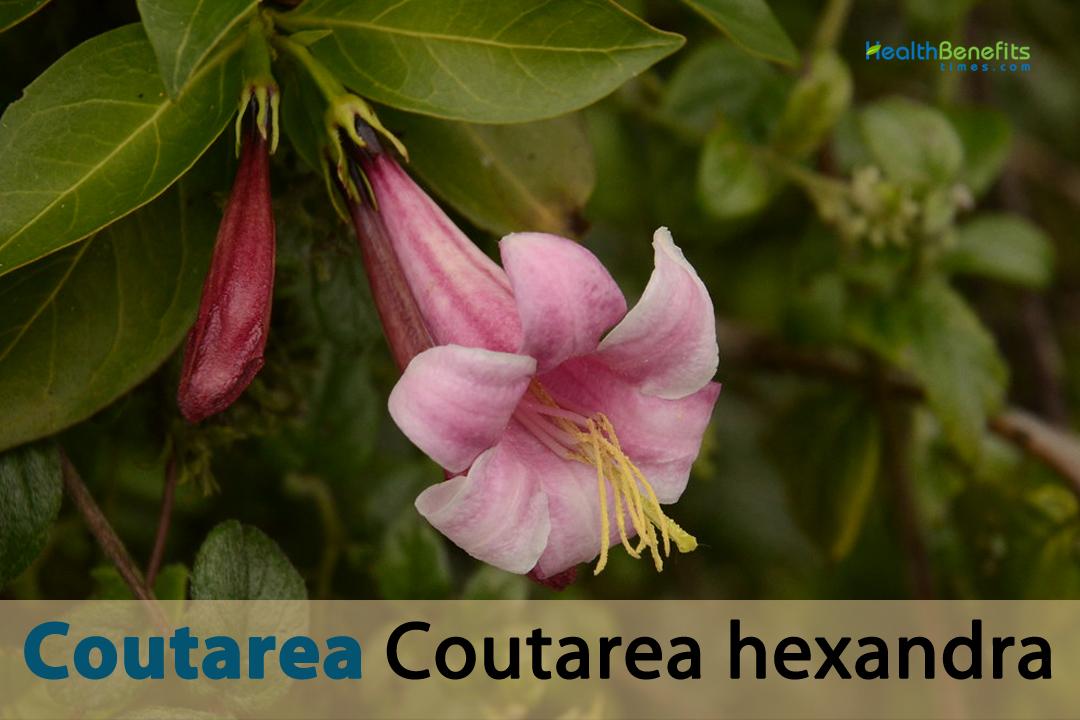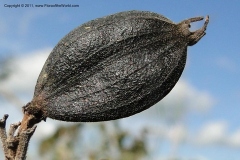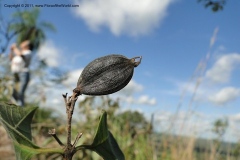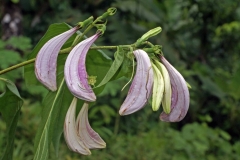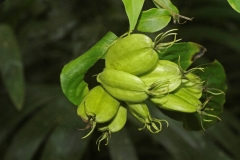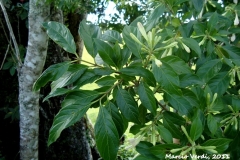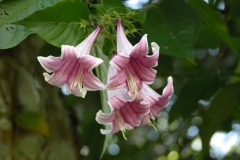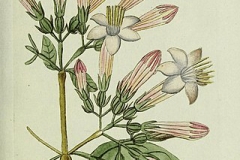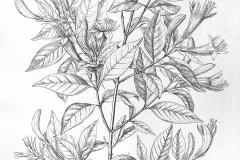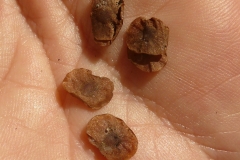| Coutarea Quick Facts | |
|---|---|
| Name: | Coutarea |
| Scientific Name: | Coutarea hexandra |
| Origin | Tropical and subtropical regions of Central and South America |
| Colors | Red, orange, or other colors when mature |
| Shapes | Some produce elongated capsules while certain species produces berry-like fruits |
| Taste | Bitter and astringent |
| Health benefits | Pain Relief, Immune System Support, Wound Healing, Cardiovascular Health, Blood Sugar Regulation, Weight Management, Liver Health, Respiratory Health, Pain Management in Arthritis, Stress Reduction, Gastrointestinal Disorders and Skin Health |
| Name | Coutarea |
|---|---|
| Scientific Name | Coutarea hexandra |
| Native | Tropical and subtropical regions of Central and South America, where it can be found in countries like Brazil, Colombia, Honduras, Venezuela, Nicaragua, Costa Rica, and others |
| Common Names | Guiana Chestnut, Black Damson Tree, Black Wattle, Caribbean Trumpet Tree, Cabbage Tree, Jamaica Dogwood, Guyana Chestnut, Squirrel wood, Naseberry Tree, Siricote, Dogwood Tree, Coutari |
| Name in Other Languages | Angika: Koutariya (कौटरिया) Arabic: Kutarria (كوتاريا) Assamese: Koutaria (কৌটৰিয়া), Kewariya (কেৱৰিয়া) Bengali: Kutaria (কুতারিয়া), Koutaria (কোউটারিয়া) Bodo: Koutariya (कौटारिया) Chinese: Kù tǎ léi yà (库塔雷亚) Chhattisgarhi: Koutariya (कौटरिया) Dutch: Coutarea English: Coutarea French: Coutaréa à six étamines, Coutarea Garhwali: Koutariya (कौटरिया) German: Coutarea Greek: Koutarea (Κουταρέα) Gujarati: Kotariya (કોટારીયા) Hebrew: Kutariya (קוטריה) Hindi: Kutaria (कूटारिया), Coutarea Indonesian: Coutarea Italian: Coutarea Japanese: Kutarea (クタレア), Koutarea hekisandora (コ ウタレア・ ヘ キサンドラ) Kannada: Kautariya (ಕೌಟಾರಿಯಾ) Kashmiri: Koutariya (کوتاریا) Kokborok: Kautariya (কৌতরিয়া) Konkani: Koutariya (कौटारिया) Korean: Kuta rea (쿠타레아) Kumaoni: (Koutariya (कौटरिया) Maithili: Koutariya (कौटरिया) Malay: Coutarea, Koutarea Malayalam: Kottareya (കൊട്ടാരേയ) Manipuri: Kautariya (কৌতরিয়া) Marathi: Kotaria (कोटारिया) Nagpuri: Koutariya Nepali: Koutariya (कौटारिया) Odia: Koutariya (କୌଟାରିଆ) Persian: Kutaria (کوتاریا) Portuguese: Capança-vermelha, Capirona, Amora-do-mato, Jberema-pau-de-quina, Murta-do-mato, Quina, Quina-branca, Quina-de-dom-diogo, Quina-de-pernambuco, Quina-do-mato, Quina-do-pará, Quina-do-piauí, Quina-quina Punjabi: Koutariya (ਕੌਟਾਰਿਆ) Russian: Kutareya (Кутарея) Sanskrit: Kautariya (कौटरिया) Sindhi: Kautariya (ڪوٽاريا) Spanish: Niño muerto, Quina blanca, Quinita, Zalas, Bonita de noche, Cabrito negro, Caruto, Cascarillo, Guatare amarillo, Huacamayo caspi, Niño muerto, Quina, Quina blanca, Quinita, Salas, Zalas Swahili: Kutarea Tamil: Kūṭṭāriyā (கூட்டாரியா), Kottareya (கோட்டாரேயா) Telugu: Kotaareya (కొటారేయ) Thai: Kūtāreīyā (คูตาเรีย) Tulu: Koutariya (ಕೌತರಿಯ) Turkish: Kutarea Urdu: Koutariya (کوٹاریہ) Vietnamese: Coutarea |
| Plant Growth Habit | Semi-deciduous shrubs or small to medium-sized trees |
| Growing Climates | Dense tropical rainforests, forest edges, open woodlands, riverbanks, streams, savannas, lowland and montane forests, secondary forests, swampy or marshy areas |
| Soil | Prefers well-draining, slightly acidic to neutral soil with good organic matter content |
| Plant Size | 4 – 6 meters tall and has a short, usually crooked bole 15 – 25 cm in diameter |
| Root | Fibrous root system, which consists of numerous thin, branching roots that spread out extensively in the soil |
| Stem | Semi-woody to woody stem which may be smooth or rough-textured and may branch out into smaller stems or branches as they mature |
| Bark | In younger stems, the bark may be thinner and more flexible, while older stems may have thicker and more rigid bark |
| Leaf | Glossy, dark green, and elliptical or lance-shaped. They have smooth or slightly wavy margins and a pointed tip. The leaves are arranged alternately along the branches. They are about 5 to 15 cm long and 1 to 4 cm wide |
| Flower | Small, tubular or funnel-shaped flowers that are typically white or cream-colored. These flowers are arranged in clusters or inflorescences |
| Fruit Shape & Size | Some produce elongated capsules while certain species produces berry-like fruits |
| Fruit Color | Berries may be red, orange, or other colors when mature Capsules may turn brown |
| Fruit Weight | Few grams to a fraction of an ounce (less than 1 ounce) |
| Fruit Skin | Thin and smooth skin |
| Seed | Typically small, ovoid or spherical in shape, often brown or dark-colored |
| Taste | Bitter and astringent |
| Plant Parts Used | Bark, leaves, Roots, fruits, seeds, resins |
| Propagation | By seed, stem cuttings, Air layering and division |
| Lifespan | Within a year to several years or even decades |
| Available Forms |
|
| Health benefits |
|
Plant Description
Coutarea is a semi-deciduous shrub or small to medium-sized tree with a typically crooked, 15–25 cm-diameter bole that matures to a height of 4–6 meters. Rarely have specimens reaching a height of 18 meters been documented in certain regions, including Costa Rica. It can develop into a shrub with stems that frequently intertwine with the surrounding vegetation, or it can assume the form of a tree with an exceptionally dense, globose crown. Dense tropical rainforests, forest edges, open woodlands, riverbanks, streams, savannas, lowland and montane forests, secondary forests, swampy or marshy areas are all habitats for this plant. The plant prefers slightly acidic to neutral, well-draining soil that is rich in organic matter. The optimal soil is loamy, which retains moisture without becoming waterlogged.
Coutarea hexandra thrives in an environment that is both mild and humid. It prefers mildly acidic to neutral, well-draining soil that is rich in organic matter. Sufficient sunlight, consistent moisture, and frost protection are critical factors that dictate its growth. It is frequently cultivated for ornamental purposes. The plant is frequently employed in place of quinine for the treatment of malaria. It is frequently extracted from its natural habitat for this objective as well as for its timber. Due to its diminutive stature, this ornamental plant can be cultivated in confined spaces and beneath power lines. Similar to numerous tropical plant species, the plant in question might encounter habitat degradation and conservation obstacles as a result of land development and deforestation. It could potentially require conservation efforts to safeguard its natural habitats.
Appropriate growing environment for Coutarea
Coutarea is a tropical and subtropical plant that thrives in specific environmental conditions that mimic its natural habitat. Here are the key factors that make for an appropriate growing environment for coutarea:
- Climate: The mild and humid climate that characterizes tropical and subtropical regions is what Coutarea prefers. Due to its sensitivity to frost, cultivation should occur in regions where nighttime temperatures do not fall below zero.
- Temperature: Coutarea thrives at temperatures ranging from 70°F to 85°F (21°C to 29°C). Although it can withstand brief temperature variations, it must be shielded from extended periods of low temperature.
- Sunlight: Coutarea can grow in broad to complete sunlight. Daily exposure to a minimum of four to six hours of direct sunlight is advantageous. Nonetheless, it can also withstand some shade, particularly during the warmest hours of the day.
- Soil: The plant prefers slightly acidic to neutral, well-draining soil that is rich in organic matter. The optimal soil is loamy, which retains moisture without becoming waterlogged.
- Watering: Coutarea prefers a moist environment but requires consistent moisture. When the soil in the uppermost inch becomes dried, water the plant. It is critical to have adequate drainage in order to avoid root decay.
- Humidity: Increasing levels of humidity are advantageous for coutarea. In an arid climate, one might contemplate augmenting the surrounding humidity of the plant via techniques such as misting or employing a humidity receptacle.
- Fertilization: Consistent and well-balanced fertilizer application is advantageous for Coutarea throughout the growing season, which typically occurs in the spring and summer. Apply a diluted liquid fertilizer for general use, rated at half strength, every two to four weeks.
- Pruning: When necessary, prune coutarea to preserve its form and promote luxuriant growth. Destroy damaged or dead branches and spent blossoms in order to stimulate new growth.
- Pest and Disease Management: It is advisable to remain vigilant for prevalent garden pests such as mealy bugs and aphids and implement suitable control measures. Ensure adequate air circulation in order to avert fungal infections.
- Container Gardening: Coutarea can be cultivated in containers and subsequently transferred indoors during colder months in regions characterized by unsuitable climates. Ensure that the container has adequate drainage, and select a potting mix that drains well.
- Protection from Extreme Weather: Protect the plant if you reside in an area prone to heavy precipitation or strong winds; doing so will help prevent damage.
Roots
Coutarea commonly produces a fibrous root system characterized by an abundance of slender, branching roots that extend widely throughout the soil. These roots exhibit a relatively shallow depth of penetration into the soil. Fibrous roots typically remain in close proximity to the soil’s surface, frequently occupying the uppermost few inches to one foot. The plant’s ability to efficiently absorb nutrients and moisture from the topmost layers of soil is facilitated by its shallow root system. Coutarea has the potential to generate adventitious roots, which are roots that originate from plant elements other than the roots themselves, including stems and leaves. In particular, these roots can facilitate the assimilation of nutrients and water in response to shifting environmental conditions.
Thin structures resembling filaments, known as root hairs, adorn the fine roots, augmenting their overall surface area. The function of root filaments is vital: to absorb nutrients and water from the soil. From the base of the plant emanate lateral branches that comprise the fibrous root system. This branching pattern maximizes the plant’s capacity to explore a greater volume of soil for resources and aids in its anchoring in the soil.
Stem
The stem of the woody plant Coutarea exhibits a texture that ranges from semi-woody to woody. Whether it matures into a tiny tree or a shrub depends on its environment and age. Bark constitutes the protective outer layer that envelops the stem. Bark color and texture may differ depending on the maturity of the plant; however, it is commonly observed to have a coarse texture and can be found in shades of gray or brown. Underneath the epidermis resides the innermost layering of the stem’s tissue. The bark constitutes the exterior layer, followed by the phloem, which serves the purpose of conveying nutrients generated in the leaves to subsequent anatomical locations within the plant. The cambium, a layer of actively proliferating cells that generate new phloem and xylem cells, lies beneath the phloem. From the roots to the remainder of the plant, water and minerals are transported via the xylem, the innermost stratum.
There may be annual growth rings on elder coutarea stems, which resemble those observed on tree trunks. The growth patterns of the plant over time are denoted by these rings, which can offer insights into the plant’s age and the environmental conditions it encountered throughout its various growing seasons. Depending on the variety or environmental conditions, the stem’s color may fluctuate, but it typically transitions from green to brown or gray as it ages.
Bark
Bark of the genus Coutarea is typically coarse and gritty in texture. The surface may have a rough or irregular texture, which is typical of numerous woody plants. Although the hue may differ, it is frequently gray or brown tones. The precise shade may vary depending on environmental factors and the maturity of the plant. Bark thickness fluctuates in accordance with the age of the stem. The bark of juvenile stems may be more flexible and thin, whereas the bark of older stems may be denser and more rigid.
Similar to numerous woody plant species, its bark functions as a defensive outer covering. It aids in protecting the inner stem tissues against pathogens, physical injury, and environmental stresses. Herbivores are deterred by the rough texture and rigidity, which also serve as a barrier against external hazards. Bark that has deep furrows and crevices may have a corky appearance. Furthermore, they provide additional protection against abrasion and environmental elements and contribute to the material’s robust texture.
Leaves
Along the stem, coutarea leaves are typically arranged alternately. This indicates that the positions of the leaves along the stem alternate rather than being precisely opposite one another. The typical shape of Coutarea fronds is elliptical or lance-shaped. They have a tapering base and a pointed apex; they are long and slender. Although variable, leaf margins are typically flat or slightly undulating. While certain specimens may possess complete smooth margins, others may display minute canines or serrations along the periphery. Veins that flow prominently through the leaves. Frequently visible on both the upper and lower leaf surfaces, these veins aid in nutrient and water transport within the leaf.
Depending on environmental conditions and the maturity of the plant, leaf size may differ. In general, their dimensions are 1 to 4 centimeters (0.4 to 1.6 inches) in breadth and 5 to 15 centimeters (2 to 6 inches) in length. The upper surface of coutarea leaves is typically glossy and smooth, whereas the lower surface may be faintly hairy or comprise fine hairs. Typically, the upper surface of foliage exhibits a dark green hue, while the lower surface displays a lighter green hue. The precise hue of green may differ due to environmental influences. Coutarea leaves have a pinnate venation pattern, meaning that the veins emanate from a central midrib in the form of a feather-like arrangement. Coutarea leaves are supported by slender petioles, which are the stems of the leaves. The petioles serve to join the leaves to the primary stem.
Flowers
Inflorescences, which are terminal or axillary clusters, are the typical arrangement of flowers in Coutarea. These clusters may consist of numerous individual flowers and may differ in size. Typically funnel- or tubular in shape, coutarea flowers have a narrow base that enlarges toward the apex. The morphology of the object promotes pollinator attraction and facilitates nectar access. Although the hue may differ, it is frequently white or ivory in color. The particular hue exhibited by the flower may be contingent upon its variety, environmental circumstances, or age. The diameter can vary between approximately 2 and 3 centimeters (0.8 and 1.2 inches). Comparatively diminutive and unremarkable in nature, they differ from certain other blossoming plants.
Five petals are typically fused together to create the tubular or funnel-shaped structure of coutarea flowers. Frequently, these sepals fold back slightly or overlap. The male reproductive organs of the flower consist of numerous stamens, which are accountable for the secretion of pollen. While the precise number may differ between flowers, it is generally greater than five stamens. The female reproductive organ of the flower, the pistil is composed of the following: stigma, style, and ovary. Each flower is composed of a solitary pistil. Coutarea flowers yield nectar, which pollinators, including bees and butterflies, utilize as a reward. The tubular structure of the flower serves as a repository for the nectar.
Fruits
Coutarea is capable of yielding a variety of crops, such as capsules and berries. The precise fruit variety may differ contingent upon the variety of coutarea. As fruits, certain species of coutarea produce elongated capsules. When mature, these capsules frequently rupture open, discharging the seeds contained within. Certain species of coutarea produce fruits that resemble berries. When fully mature, these berries beget seeds and acquire a fleshy consistency. Fruits may differ in dimension; capsules, on average, have a greater diameter than berries. They may vary in diameter or length from a few to several centimeters. The pigmentation of fruits may differ depending on the species and maturity stage. At maturity, berries may exhibit hues such as red, orange, or other vibrant colors. Conversely, capsules have the potential to transform into brown or open, thereby exposing the seeds.
Seeds
Coutarea seeds generally exhibit a diminutive dimension, although this characteristic can differ among distinct species and varieties of coutarea. In general, their morphology is ovoid or spherical. Although coutarea seeds can be any shade of brown, they are typically that of a dark hue. Particular seed pigmentation may be influenced by variables including species variation and seed maturity. The primary means by which seeds are disseminated to novel areas are through natural processes. The precise mechanisms may differ in accordance with the habitat and variation of the coutareal. Seed dispersal is frequently facilitated by wind, water, and animals.
Health benefits of Coutarea
Coutarea is a tropical plant native to South and Central America. While its health benefits are not as extensively studied as some other herbs and plants, there are several potential health benefits associated with coutarea:
1. Anti-inflammatory Properties
The presence of anti-inflammatory compounds in coutarea may contribute to the reduction of inflammation throughout the body. There is a correlation between chronic inflammation and a range of health complications, such as cardiovascular disease, rheumatoid arthritis, and digestive disorders. Coutarea consumption may aid in the management of inflammation.
2. Pain Relief
In traditional medicine, coutarea is utilized to alleviate discomfort. It is frequently applied to relieve joint pain, muscle aches, migraines, and general discomfort. The hypothesized analgesic effect may be attributed to the substance’s anti-inflammatory characteristics.
3. Digestive Aid
Historically, coutarea has been employed to promote digestive health. Predicated on popular belief, it alleviates bloating, dyspepsia, and gastrointestinal distress. Coutarea is utilized to treat diarrhea in some cultures, but additional research is required to confirm its efficacy in this regard.
4. Antioxidant Activity
Antioxidants including quercetin and coutaric acid are present in coutarea. By neutralizing harmful free radicals in the body, these compounds may potentially lower the risk of chronic diseases such as cancer and cardiovascular disease and reduce oxidative stress.
5. Immune System Support
Although scientific research on the immune-boosting properties of coutarea is limited, it is frequently employed in traditional medicinal practices to treat minor ailments such as influenza and colds. Immuno stimulating effects of the plant are possible, but additional research is required to corroborate this.
6. Wound Healing
For the purpose of promoting wound healing, coutarea has been administered topically in specific cultures. The potential therapeutic impact of its anti-inflammatory properties on the lesion site is a reduction in inflammation, which could facilitate the healing process.
7. Antimicrobial Potential
Certain laboratory investigations have postulated that coutarea might exhibit antimicrobial characteristics. More research is required to ascertain its clinical applications, but this suggests that it might be effective against specific bacteria and fungi.
8. Antiviral Properties
Preliminary investigations have suggested that coutarea might possess antiviral characteristics, boding further investigation into its potential utility in addressing viral infections. Despite this, the field of study is still in its nascent phase.
9. Cardiovascular Health
Coutarea potentially exerts a beneficial influence on cardiovascular health. Antioxidant properties may reduce oxidative stress and inflammation in the cardiovascular system, thereby decreasing the risk of cardiac diseases such as coronary artery disease, according to some research.
10. Blood Sugar Regulation
Coutarea has historically been employed for the purpose of blood sugar regulation. Initial research suggests that it might induce a slight hypoglycemic response, which could be advantageous for those who already have diabetes or are at risk of developing the disease.
11. Weight Management
Coutarea potentially aids in weight management through its anti-inflammatory and antioxidant properties, which may inhibit inflammation in adipose tissue and promote metabolic health. More research, however, is required to establish a direct link.
12. Liver Health
Traditional medicine has utilized coutarea to assist in detoxification and promote liver health. Several studies have indicated that it potentially possesses hepato-protective properties, thereby safeguarding the liver against toxin-induced injury.
13. Respiratory Health
Coutarea is utilized to treat respiratory conditions such as asthma and bronchitis in some cultures. Antimicrobial and anti-inflammatory properties have the potential to mitigate respiratory symptoms; however, additional research is necessary to confirm these effects.
14. Anticancer Potential
In laboratory experiments, certain coutaric acid and other coutarea-derived compounds have demonstrated potential as anticancer agents. It is crucial to note, nevertheless, that these results are preliminary in nature; further investigation is required to ascertain their clinical implications.
15. Pain Management in Arthritis
Coutarea, by virtue of its analgesic and anti-inflammatory characteristics, might provide arthritis sufferers with alleviation by diminishing joint pain and inflammation.
16. Stress Reduction
Coutarea has been utilized historically as a natural remedy for anxiety and tension. Scientific evidence is limited; however, it is plausible that its potential calming effects originate from its influence on inflammation and the nervous system.
17. Gastrointestinal Disorders
Coutarea has been historically employed as a digestive supplement to address a range of gastrointestinal concerns, such as irritable bowel syndrome and gastritis. It may alleviate symptoms and aid in the digestion.
18. Skin Health
Coutarea has been utilized topically to treat skin conditions such as insect bites, dermatitis, and eczema, on account of its potential anti-inflammatory and wound-healing attributes.
Culinary uses of Coutarea
Coutarea is not commonly used as a culinary ingredient in many cultures. It is primarily recognized for its potential medicinal properties and traditional uses in herbal medicine. However, there are some limited culinary applications and indigenous practices where coutarea has been used:
- Flavoring Agent: Coutarea, which is indigenous to specific areas of South and Central America, has historically been utilized as a culinary additive in traditional preparations. By incorporating the leaves or bark of the plant into soups, stews, and sauces, one can impart a distinctive and mildly astringent flavor.
- Herbal Tea: An herbal tea can be brewed from coutarea foliage. Traditionally, the tea is made through the steeping of fresh or desiccated leaves in hot water. In order to enhance the flavor, it is occasionally sweetened with honey or other natural sweeteners, despite its potentially acrid taste.
- Condiment: Coutarea leaves are delicately chopped and utilized as a condiment or seasoning in certain cultural contexts to augment the taste of a variety of dishes. This application is relatively uncommon in comparison to other culinary herbs and seasonings.
- Ethnic and Indigenous Dishes: Particular indigenous cuisines may assign greater significance to coutarea in the context of particular traditional dishes. However, its culinary application is predominantly regional and not widely acknowledged in conventional cuisine.
- Bittering Agent: Coutarea possesses a bitter flavor, rendering it comparable in utility to alternative bittering agents such as quinine or gentian. Coutarea may be employed in specific cocktail formulations, specifically craft cocktails and herbal liqueurs, to impart an astringent and herbal quality to the overall flavor profile.
- Bitter Greens: In culinary preparations, coutarea leaves may be utilized as an astringent green or added to salads. Similar to dandelion greens and arugula, they have the ability to impart a discernible bitterness to salads and various other composed dishes.
- Seasoning Agent: Coutarea bark or leaves may be desiccated and pulverized into a powder in certain instances. When seasoning or spicing savory dishes, this powder should be utilized sparingly, particularly those that would benefit from an herbal or astringent taste.
- Bittering Agent in Cocktails: The bitter flavor of coutarea can be utilized as a natural bittering agent in cocktail preparations. Craft cocktails occasionally incorporate it as a means to impart a distinctive bitterness and aromatic intricacy. Coutarea can be infused into alcoholic beverages such as vermouth or gin to produce distinctive cocktail flavors.
- Herbal Liqueurs: Coutarea is utilized in some cultures to produce botanical liqueurs and aperitifs. As a digestive aid, these liqueurs are frequently consumed before or after meals. The bitterness and herbal undertones of coutarea may serve as a crucial element in the flavor composition of these beverages.
- Flavoring for Soups and Stews: Soups and stews are occasionally seasoned with coutarea bark or leaves in accordance with regional culinary customs. In order to impart a delicate bitterness and herbal undertone to the dishes, they are utilized in moderation.
- Bitter Greens in Salads: Coutarea leaves, like arugula and endive, can be incorporated into salads as astringent greens. Salads can benefit from the distinctive bitterness and profound flavor that they impart, especially when harmonized with other components such as acidic or sweet elements.
- Condiment or Seasoning: Bark or dried coutarea leaves may be utilized in moderation as a seasoning or condiment. Dishes may be dusted with it in order to introduce an aromatic and bitter flavor. Nevertheless, its intense acidity necessitates its application in limited amounts.
- Infused Oils and Vinegars: Through the infusion of oils or vinegars with coutarea, one can produce distinctively flavored foundations for salad dressings or marinades. The infusion method facilitates the transformation of the acrid and aromatic properties of coutarea into the oil or vinegar.
Different uses of Coutarea
Coutarea is a tropical plant with various traditional and potential uses beyond culinary and medicinal applications. Here are different uses of coutarea:
- Topical Applications: Coutarea has been applied topically to ameliorate skin conditions such as insect bites and rashes and to promote wound healing due to its potential antimicrobial and anti-inflammatory properties.
- Infused Spirits: Coutarea bark or leaves can be used to infuse alcoholic beverages such as vodka, gin, or vermouth with a distinctive botanical flavor.
- Agriculture: Coutarea is utilized in agricultural practices in certain regions. For the protection of vegetation, it can be utilized as a natural insect repellent or pesticide.
- Traditional Rituals: Coutarea may serve ceremonial or ritualistic purposes in specific indigenous cultures. As part of their cultural heritage, it might be integrated into customary ceremonies or practices.
- Biodiversity Conservation: Coutarea is a native plant species in specific regions; therefore, in order to preserve biodiversity and ecological equilibrium, efforts may be made to protect and conserve its natural habitat.
- Research and Development: Coutarea may be investigated by scientists and researchers in an effort to gain a deeper comprehension of its chemical makeup, potential therapeutic attributes, and ecological importance.
- Educational Purposes: Educational and cultural initiatives aiming to disseminate indigenous knowledge and practices might find the distinctive attributes and traditional applications of coutarea intriguing.
- Dye Production: By utilizing coutarea, one can generate natural dyes. The bark and foliage comprise compounds that, when processed and applied to textiles, fabrics, or craft materials, produce an array of hues.
- Crafts and Art: Coutarea may be utilized in ancient arts and crafts in some indigenous cultures. It can be used to add color or distinctive textures to pottery, basket weaving, and other artistic endeavors.
- Insect Repellent: Coutarea potentially possesses inherent insecticidal properties. Dried coutarea bark or leaves may be utilized as an incense in specific geographical areas to ward off insects and mosquitoes.
- Traditional Rituals and Ceremonies: Coutarea may possess ceremonial or spiritual importance within specific indigenous rituals. It can be utilized in sacred practices, offerings, and ceremonies to establish a connection with nature or the spiritual realm.
- Traditional Textiles: Coutarea may be utilized in the construction of traditional textiles in certain cultures. It can be woven into fabrics to impart variations in texture and hue.
- Environmental Restoration: The presence and proliferation of coutarea in natural ecosystems may aid in environmental restoration initiatives. To support biodiversity, it may be utilized in reforestation and habitat restoration initiatives.
- Cultural Heritage: Coutarea may play a crucial role in the conservation of cultural heritage. Its incorporation into ceremonies, rituals, and traditional practices aids in the preservation of indigenous communities’ cultural identities.
- Scientific Research: Researchers investigating traditional ecological knowledge, ethno-botany, or biodiversity may find Coutarea to be of interest. Its research has the potential to enhance knowledge regarding the ecological function and cultural importance of the plant.
- Landscaping and Ornamental Use: Wherever coutarea is indigenous, it can be cultivated for aesthetic purposes in landscaping or garden designs. Its unique foliage can enhance the aesthetic appeal of landscapes.
- Natural Pest Control: The natural compounds found in coutarea may find utility in organic insect control techniques utilized in agriculture. Bio-pesticides could potentially be derived from plant extracts.
Side effects of Coutarea
Coutarea is a plant with potential medicinal properties, but like many herbal remedies, it may have side effects or potential risks, particularly when used inappropriately or in excess. It’s essential to exercise caution and consult with a healthcare professional before using coutarea or any herbal remedy. Here are some potential side effects and considerations associated with coutarea:
- Gastrointestinal Discomfort: When consumed in excess of recommended amounts or without dilution, the bitter flavor of coutarea may occasionally induce gastrointestinal distress such as nausea, vomiting, or stomach disturbance.
- Allergic Reactions: Certain individuals may develop allergic reactions to coutarea or its constituents, manifesting as respiratory symptoms, skin rashes, or pruritus. One should exercise caution if they have a sensitivity to plants in the Rubiaceae family, to which coutarea is a member.
- Drug Interactions: Coutarea has the potential to induce drug interactions with specific medications, including anticoagulants, blood-thinning drugs, and antiplatelet drugs, which could escalate the risk of hemorrhage. While taking any medications, it is imperative that you consult a healthcare professional in order to prevent potential drug interactions.
- Pregnancy and Breastfeeding: Coutarea should be avoided by pregnant or breastfeeding women due to the lack of available safety information. Before using any herbal remedy during pregnancy or while lactating, it is always advisable to consult a healthcare professional.
- Liver Health: Coutarea’s hepatotoxicity (potential to damage the liver) has received scant attention in scientific research, and its effects on the liver remain poorly understood. It is advised that individuals with liver conditions or those who are on medications that impact liver function exercise caution and seek medical supervision when using coutarea.
- Excessive Bitterness: Coutarea is renowned for its potent acidic flavor. Overconsumption may result in an unfavorable gustatory encounter and has the potential to interfere with digestion or appetite in certain individuals.
- Skin Sensitivity: Coutarea preparations, when administered topically, may induce skin sensitivity or irritation in certain individuals. It is recommended to conduct a patch test prior to applying coutarea-based topical remedies to a more extensive area of skin.
- Drug Sensitization: There are instances in which coutarea may induce photosensitivity in the epidermis. This may elevate the likelihood of experiencing skin reactions or sunburn when exposed to sunlight.
- Inadequate Scientific Evidence: Numerous traditional uses and prospective health benefits of coutarea are not supported by substantial scientific research or clinical trials. It may not be prudent to treat medical conditions exclusively with coutarea without first consulting a healthcare professional.
- Quality and Safety: Depending on the source, refining, and preparation of coutarea products, their efficacy and safety may differ. It is imperative to procure coutarea products from reputable sources in order to mitigate potential hazards.
References:
https://pfaf.org/user/Plant.aspx?LatinName=Coutarea+hexandra
https://www.cabidigitallibrary.org/doi/10.1079/cabicompendium.15637
https://gd.eppo.int/taxon/KOUHE
https://powo.science.kew.org/taxon/urn:lsid:ipni.org:names:67491-2
https://indiabiodiversity.org/species/show/244677
https://tropical.theferns.info/viewtropical.php?id=Coutarea+hexandra
https://en.wikipedia.org/wiki/Coutarea


